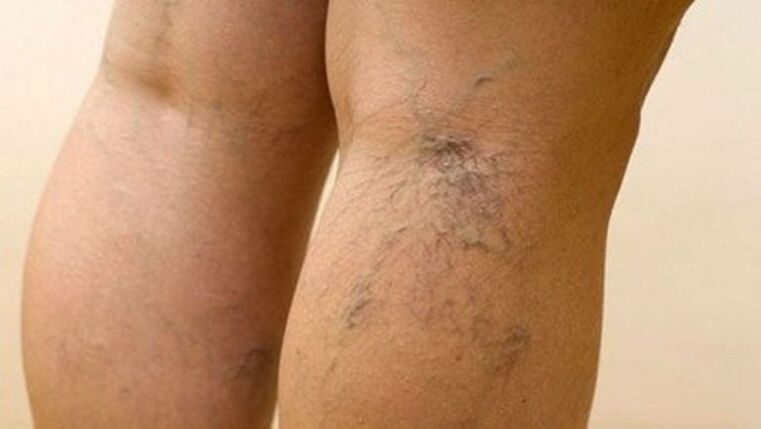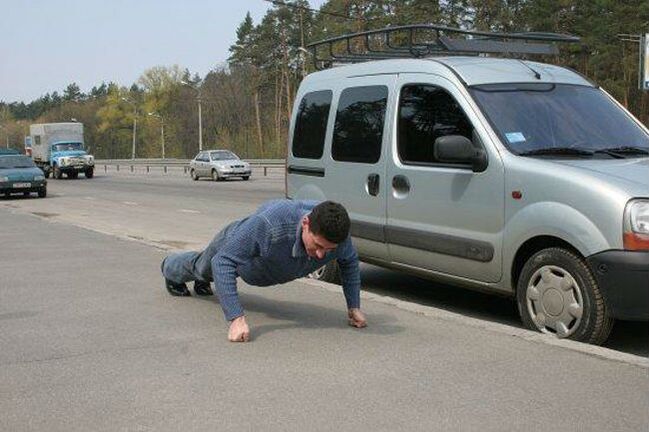
Varicose veins in the lower legs, according to information on the appeal of medical institutions, are present in every fifth man and 28% of women of working age.
If we consider the entire population, then half of the adults will experience special symptoms.
The peculiarity of this disease is the growth of comfortable living conditions. Studies in Asian countries show a lower prevalence among poor people who do manual work, walking.
Why are leg veins loaded?
The anatomical structure of the venous wall is characterized by a reinforced muscular skeleton and valve apparatus. Its convenience lies in the need not only to keep the blood flow in a person’s vertical position, but also to regulate its rise against gravity towards the heart.
The valve restricts backflow to prevent overfilling at the farthest point of the body. This "uncomfortable" place is feet and legs.
Mechanism of varicose vein formation in the legs
At the age of 40, the human body begins to synthesize a limited amount of plastic material, the main one being collagen protein. It is important for a good venous valve tone. Absence causes loss of tone, sagging and an inability to slow the backflow of blood and excess mass.
The venous network in the legs consists of superficial vessels located just below the skin, and the deep veins are located in the thickness of the muscular layer.
Varicose veins in the lower part of the leg are characterized by early lesions of the superficial venous valves. Congestion manifests itself in areas with dilated fine veins, which are visible to the eye in the form of fine nets.
Further pathological development leads to retention of blood at the periphery and causes tissue edema (fluid exits through the venous wall), malnutrition (reduced outflow of toxins, oxygen and nutrients retained by the squeezed arteries).
How complications join
Stagnation of venous blood in the legs causes slow blood flow in the blood vessels, and this creates favorable conditions for the aggregation (adhesion) of platelets. Blood clotting complicates an already disrupted blood supply.
The risk of rupture of the embolus and its movement through the large ducts to the heart is increased. If a person has a defect associated with right and left space communication, there is a possibility of embolus entering the arterial blood and the development of necrotic changes in the organ.
The most common concomitant complication is the addition of a local infection in the affected venous wall area, followed by the development of phlebitis or thrombophlebitis.
The cause of the disease
For varicose veins in the lower legs, there is only one reason that does not depend on a person - a genetic deficiency in the structure of collagen. It manifests itself not only in varicose veins, but also in the early signs of skin aging (dryness, deep wrinkles).
Other reasons are related to people’s activities and behaviors.
- Decreased physical activity or, conversely, hard physical work causes a violation of the tone of the leg veins.
- Prolonged forced standing, sitting at work causes blood stasis in the legs and disrupted outflow.
- Pregnancy puts increased pressure on the pelvic organs and large veins, preventing drainage from the lower veins.
- Doctors from Asian countries have linked the growth of varicose veins of the legs in patients with addiction to the European habit of sitting in a chair or in a chair instead of bent knees.
- A comfortable high toilet requires increased muscle tension of the abdominal wall during bowel movements, stretching contributes to stagnation in the legs. During squatting, defecation is more physiological.
- Fast food habits, decreased proportion of raw vegetables and fruits in the diet cause constipation and prolonged stress.
- Smokers expose the whole body to the effects of nicotine, it acts on the veins as a paralyzing poison.
- Stylish high -heeled shoes bring improper pressure on the leg muscles and disrupt the tone of the veins.
- Regular pills, hormonal contraceptives, treatment with hormonal drugs for menopause, osteoporosis cause impaired collagen synthesis.
- Advertised slimming underwear and wearing tight jeans cause blood to get stuck in the lower part of the body.
Who should be included in the risk group
Given the listed reasons for the development of venous pathology, groups of people most likely to develop leg varicose veins should include:
- people who are professionally associated for a long time in a standing or sitting position (salesmen, teachers, hairdressers, drivers, office workers);
- women who prefer skinny jeans, shaping up underwear and high -heeled shoes;
- people involved in weightlifting and bodybuilding;
- people who are accustomed to sitting "side by side";
- women with frequent pregnancies and births, as well as taking hormonal contraceptives;
- smokers, fans of coffee and strong alcohol;
- constipation.
Preventive measures are needed for this population.
Symptoms
The first symptoms of varicose veins in the legs can be seen at a young age. In the early stages, they appear with increased pressure on the legs:
- at the end of the shift, pain appears in the legs and feet, muscle fatigue;
- while changing shoes, swelling of the feet was found due to congestion of the shoes;
- in the evening the feet "burn", you want to dip them in cold water;
- "spiders" form on the skin of the thighs and legs.

At a later stage, the picture of chronic venous insufficiency develops, symptoms of internal varicose veins appear:
- disturbed by night cramps in the calves, cramps when walking possible;
- dark spots, dryness, exfoliation appear on the skin of the feet and legs;
- appearance of trophic ulcers, very painful, with loose edges, difficult to treat.
If, against the background of localized pain, swelling, redness of the skin, there is an increase in body temperature, you need to think about thrombophlebitis.
Diagnostics
In diagnostics, it is customary to distinguish between true (primary) varicose veins, depending on the lesion of the valve apparatus, and secondary, which are caused by trauma and tumors.
Polyclinic surgeons, vascular surgeons, phlebologists are involved in the examination. Doctors look at subcutaneous venous nodes, vascular tissue, skin pigmentation, ulcer onset, dermatitis.
On palpation, superficial vein tension, wall density, local change measurements, presence of thrombus, skin temperature above the node (signs of thrombophlebitis) were assessed.
General blood tests will show the onset of inflammation (leukocytosis, accelerated ESR), the tendency of thrombus formation according to the coagulogram.
Vascular ultrasound allows you to track blood flow, venous valve function, and detect blood clots.
Doppler examination allows you to examine the structure of the veins, to make a diagnosis at an early stage of the disease.
A spiral computed tomography method is performed in case of difficulties in diagnosis. This makes it possible to obtain a three -dimensional picture of the anatomical area, and assists in the choice of surgical treatment.
Treatment of varicose veins on the legs
It is better to start the treatment of leg varicose veins at an early stage. To do this, you have to think about the changes needed in habits, diet, and movement.
Mod
In order for the feet not to swell at the end of the working day, people who are "inactive" and "professionally standing" are advised to do rest or physical cultural warm-up with a foot massage in an elevated position. Drivers, office workers must take a walk during breaks.
The simplest exercises can be done in the workplace:
- barefoot on the floor alternately standing on feet and heels;
- sit on a chair, lift your legs and make a circle with your feet in one direction, then in the other.
Morning exercises must include exercises in the lying position: alternate leg raises, "bicycles", rocking the raised leg. Exercises with squats, bent knees are not appropriate.
Lovers of strength training should reject them. The most widely shown are swimming, biking, and hiking.
Balanced food selection
Limit all foods that add weight, increase fluid retention, and increase blood viscosity.
Fatty meats and dairy products, spicy and salty foods, canned foods, sweets, baked goods, carbonated drinks are not recommended.
In the daily diet, you should use more vegetables and fruits, berries, onions, garlic, fermented dairy products, cereals, vegetable oils are indicated instead of butter, walnuts.
Venous support methods
Wearing compression stockings or golf is recommended to support blood flow. They are sized to wear while lying on your back.
The silicone sole is filled as a drug that creates an electrical charge on the surface of the foot.
Experts note the possible effect of this help only in the early stages of the disease. If there are varicose veins and edema in the legs, its use is completely useless.
Use of drugs
Drug treatment consists of the oral administration of drugs from the "venotonic" group in therapeutic doses chosen by the physician. They help relieve fatigue, discomfort in the legs, but they do not eliminate the disease.

Surgeons associate medication for varicose veins as a background conservative treatment, but the main one is one of the less traumatic ways to affect the affected vein. Its effectiveness was confirmed in 95% of patients. More serious interventions were used in only 5% of patients.
What to do with low trauma surgery
Low traumatic methods of treating varicose veins allow you to avoid surgery, accurately being in the first position in terms of effectiveness. They do not require skin incisions, can be done in a polyclinic, and are practically painless. Patients are not limited in terms of occupation, movement. A long recovery period is not required after surgery.
Laser ablation method
It is performed under local anesthesia. A light indicator is inserted into the varicose vein, and a circular laser beam is turned on during the reverse movement.
Method action: the beam causes significant deep venous lining burns, hardening. The duration of the intervention was about two hours. This method can be used in the treatment of veins of various sizes.
Sclerotherapy techniques
Material is injected into the affected vein which can cause the wall to collapse with subsequent scarring. A foam preparation is highly recommended, which quickly and safely fills the lumen of the diseased vein. This method can be used when the vessel diameter is up to 1 cm. Once introduced, it is necessary to walk for an hour. Phlebologists recommend wearing compression stockings for another month.
Microphlebectomy method
Under local anesthesia, an incision is made in the skin a few mm, in which the sore vein is gripped by a hook, brought to the surface of the skin and cut. This method is suitable for venous nodes of any size and diameter. Small scars will remain at the incision site. You must wear stockings or compression stockings for 10 days.
Radio frequency ablation method
It is performed similarly to a laser, but differs in the influence of microwave radio frequencies. This method does not cause tissue burns, therefore it is less traumatic than laser. After 30 minutes of exposure to microwaves, the vessel lumen was closed. After 7 days, recovery is considered complete. You can play sports.
In what case is the operation indicated?
With unsuccessful treatment with conservative methods and the impossibility of using minimally invasive techniques, phlebectomy surgery was prescribed. It allows you to remove large areas of varicose veins, bundles.
The patient was hospitalized. Surgical treatment is performed under general anesthesia. Usually two incisions are made: in the groin area and below the knee. The veins are tied on both sides, pulled out and removed. Sutures are applied to the incision. The patient was hospitalized for a week. Drugs that reduce blood clotting are used. Sutures were removed after at least 7 days.
Phlebectomy not performed:
- in the old age of the patient;
- with great damage to the deep and superficial veins;
- during pregnancy;
- with atherosclerosis of the canal, diabetes mellitus;
- if there is skin disease at the proposed surgical site.

Methods of prevention
Prevention of varicose veins on the legs is very necessary for people who have risk factors in this profession.
Walking more is recommended. There is massage and strengthening of the vein walls.
During the break, vendors and hairdressers were shown foot and bone massages. It is done with slow and slow movements in the direction from the fingers to the knees and along the thighs. The base of the fist is massaged in a circular motion to the middle fossa of the foot.
Drivers need to get out of the car, take a walk, stretch the legs. Exercises for the legs are shown.
Fashionistas should think about the consequences before wearing high heels and wearing tights.
At home, you can do a contrast bath or foot shower. Apply compresses on tired feet with decoctions of chamomile, chestnut, wormwood, burdock.
Timely visits to the surgeon allow you to get rid of painful problems, restore activity and movement.




































